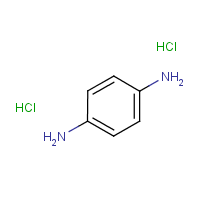1,4-Diaminobenzene dihydrochloride
Agent Name
1,4-Diaminobenzene dihydrochloride
CAS Number
624-18-0
Formula
C6-H8-N2.2Cl-H
Major Category
Nitrogen Compounds

Synonyms
p-Phenylenediamine HCl; 1,4-Benzenediamine dihydrochloride; 1,4-Phenylenediamine 2-hydrochloride; 1,4-Phenylenediamine dihydrochloride; 4-Aminoaniline dihydrochloride; C.I. 76061; C.I. Oxidation Base 10A; CI 76061; CI Oxidation Base 10A; Durafur Black RC; Fourrine 64; Fourrine DS; Oxidation Base 10A; Pelagol CD; Pelagol Grey CD; Phenylenediamine dihydrochloride; p-Aminoaniline dihydrochloride; p-Benzenediamine dihydrochloride; p-Diaminobenzene dihydrochloride; p-PD HCl; p-PDA HCl; p-Phenylenediamine dihydrochloride; p-Phenylenediamine hydrochloride; para-Phenylenediamine hydrochloride; [ChemIDplus] UN1673
Category
Amines, Aromatic
Description
White to slightly reddish solid; [ICSC] Off-white crystalline powder; [MSDSonline]
Sources/Uses
Used as an analytical reagent (milk, blood, hydrogen sulfide, and amyl alcohol), antioxidant, and in photographic developers; Used formerly in hair and eyelash dyes; [HSDB]
Comments
An eye irritant; Can be absorbed through skin; Can induce methemoglobinemia; May cause skin sensitization and asthma after prolonged contact; May cause kidney injury; [ICSC] The parent compound has caused allergic dermatitis and eye injury in humans; Emergency treatment: "Paraphenylenediamine"; In sensitized individuals, paraphenylenediamine may cause allergic contact dermatitis following application as a hair dye and asthma following inhalation; Following ingestion, can cause angioneurotic edema, methemoglobinemia, acute tubular necrosis, and hepatotoxicity; An adult died after ingestion of 3 grams of p-phenylenediamine; Another adult who ingested 1800 mg developed angioneurotic edema and acute renal failure; [HSDB] A skin, eye, mucous membrane, and upper respiratory tract irritant; May cause asthma, skin sensitization, liver atrophy, and permanent eye injury; [CAMEO] An eye irritant; May cause skin sensitization; [eChemPortal: ESIS] A mutagen; [RTECS] See "p-Phenylenediamine."
Biomedical References
Exposure Assessment
Explanatory Notes
The Guide in the Emergency Response Guidebook is for "Phenylenediamines."
Adverse Effects
Skin Sensitizer
Yes
Asthma
Yes
Methemoglobinemia
MetHgb is secondary toxic effect
Hepatotoxin
Hepatoxic (a) from occupational exposure (secondary effect) or (b) in animal studies or in humans after ingestion
Diseases, Processes, and Activities Linked to This Agent
Diseases
Occupational diseases associated with exposure to this agent:
Processes
Industrial Processes with risk of exposure: